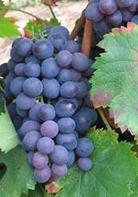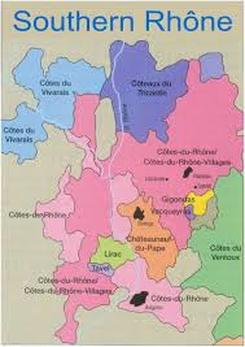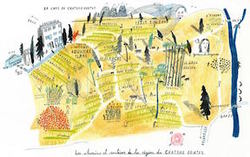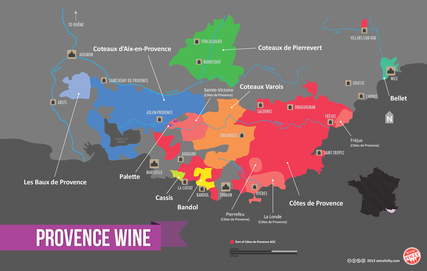 From a very minor varietal in Châteauneuf-du-Pape blend to a bloated, overgrown, tasteless red grape with anemic juice, Cinsaut would seem to have a lot to worry about in the world of viniculture. It seems it should spend sleepless nights worried about being relegated to vitis vinifera’s ugly duckling offspring. However, upon further analysis of the importance that Cinsault has played and continues to play in viniculture, both as an excellent partner in blends and as on its own, Cinsaut can be safely permitted in the greater grape pantheon, sans souci. Cinsaut (often spelled Cinsault) is a dark-skinned grape varietal traditionally used as a blending partner for Grenache, Syrah and Mouvèrde as part of the classic Southern Rhone blend. It is fairly unusual to see Cinsaut produced as a varietal wine, except as a rosé, in which it expresses itself as a light, aromatic and refreshing wine. Cinsaut vines have been grown for centuries in southern France, where it is one of the permitted minor grape varieties in the Châteauneuf-du-Pape blend. Cinsaut is known under various different synonyms, for example: Black Malvoisie in California; Cinnqsaut or Cinq-saou in Languedoc, France; Cinsault in Languedoc, France as well as in Algeria, Morocco, and Tunisia; Hermitage[i] in South Africa; Ottavianello in Puglia, Italy; and Picadan Noir in Var, France.[ii] There are also several varietals that are often mistaken for Cinsaut. For example: Brun Argenté, Chichaud, Mazuela, under the name Carigan; Oreillade Noire in Languedoc and in Algeria; and Prunelard in Gironde, where Cinsaut is called Prunelat.[iii] In terms of taste, when blended as a red, it produces a soft, fruity and aromatic wine in youth that is surprisingly long-lived. It is also very well suited to the production of fresh, perfumed and fruity rosé wines. In terms of primary aromas and flavors, one finds fruit, in particular strawberry and red cherry; floral notes may be discerned; but vegetal notes are atypical. With regards to spice: perfume and paint notes can be detected. In terms of secondary bouquets and flavors; the terroir can lend musk or meat notes. Oak, when light, gives rise to vanilla, coconut and sweet wood; When heavy, oak lends to smoke, toast, and tar notes. If bottle aged, notes of cedar, cigar box, musk, mushroom, earth and, leather may be present.[iv] These profiles can be broad, as the grape varietal is used in producing rosés and reds, and as such, may give rise to quite different wines. For example, the rosés tend to have strong fruit aromas, with light flavors and a soft mouth feel; whereas the reds are soft with dark fruit aroma and a light to medium weight. With regards to its vinecutural characteristics, Cinsaut is known for late budding and mid-ripening. It produces large cylindrical, tight bunches of black grapes with fairly thick skins. With cluster stems that easily detach from the vine, Cinsaut adapts well to machine harvesting. Cinsaut is one of those varieties appreciated by growers because it easily produces a very large crop of up to 6 - 10 tons per acre. Cinsaut, therefore, is sometimes over-cropped and used as a filler-grape. This, notably, makes it difficult for many wine critics to give Cinsaut its due respect. However, when properly managed to a crop load of just 2 to 4 tons per acre, it can produce quite flavorful wines with penetrating aroma and soft tannins, that are easily drinkable in their youth.[v] Wine made from Cinsaut grapes can be very aromatic with a supple texture that soothes the palate. Fairly low in tannin, it is often made into Rosé by itself or blended, to brighten the fruit and tone down the harsher edges of other grapes. It is often blended with grapes such as Grenache and Carignan to add softness and bouquet.[vi] In terms of terroir, Cinsaut grows well in hillsides and in clay and limestone soil. Cinsaut is therefore ideally suited to the warm, dry soils of southern France. Cinsaut is generally delicate yet it copes well with heat, wind and drought. It is fertile and very productive, resistant to drought and brunissure, that is, browning of the leaves. Conversely, it is prone to rot in damp conditions. Moreover, it is not especially vigorous and its wood ages quickly. This makes it susceptible to diseases of the wood such as esca and eutypa dieback. Furthermore, it may be subject to chlorosis in calcareous soils. This arises as a result of the plant suffering from an iron deficiency and occurs in soils that are too rich in limestone. Finally, Cinsaut can also be susceptible to mites and gape moths.[vii] Since the grape is tolerant of extremely hot, dry climates, it is grown successfully in many different countries. For example, in Morocco, Cinsaut is the leading grape variety in terms of production levels. It ais also very important in Algeria, Tunisia and Lebanon. In the latter, Château Musar produces red blends from Cabernet Sauvignon, Cinsaut, Grenache, Carigan and Mouvède.[viii] Cinsaut was imported to South Africa from the south of France in the mid nineteenth century. As French vintners struggled to recover from the devastating phylloxera crisis in 1866, the South African wine industry made up for lost time by planting some 80 million high-yielding vines such as Cinsaut.[ix] In 1925 Cinsaut was crossed with Pinot Noir to create what has become South Africa's signature grape variety, Pinotage. Pinotage now overshadows Cinsaut in the vineyards of the Western Cape. Cinsaut is also grown in California, Washington State, Australia, and Italy. Yet its greatest production is in France, where over 50% of the varietal is grown and used. While total French plantings of Cinsaut fell throughout the 1980s to less than 50,000 ha/123 acres, this is still more than France’s Cabernet Sauvignon yields.[x] With these numbers, it seems appropriate to look more closely at the varietal within the French context. Two important regions in which Cinsaut is grown are in Southern Rhône and Provence.  Châteauneuf-du-Pape[xi], in the southern Rhône, is the biggest and most important specific Rhône appellation. Here, Cinsaut plays a small, but important role. Where all other appellations specify one or two, at most four, grape varietals of similar character, the tradition in Châteauneuf-du-Pape is to grow a dozen varietals with widely different characteristics. Some growers claim that each of them, even the coarse or neutral ones, add to the complexity of the wine. New plantations, however, tend to cut down the number to four or five. However, The base is always Grenache, which can make up to 80%. The other essentials are Cinsaut, Syrah, Mouvèrde, and/or white Clairette and Picpoul. Grenache and Cinsaut are described as providing strength, ‘warmth’ and softness, whereas Mouvèrde, Syrah, Muscardin and Vaccarèse as adding structure, colour, ‘cut’ and refreshment to the flavor, and the ability to live long enough to develop a bouquet.[xii] Due to its resistance to heat and drought, Cinsaut is an important grape varietal in Provence, it grows especially well in Languedoc and Bandol. While for the most part it is used in blending other wines, it has shown to be able to stand on its own in Languedoc. For example, Domaine des Terres Falmet and Domaine d’Aupilhac in the Languedoc both produced excellent examples of 100% Cinsaut.[xiii] While these wines are not to be found in Nova Scotia, it is worthy to look at a newcomer within the Côtes de Provence: Coteaux Varois. It is a more recent appellation on cooler, higher territory within Côtes de Provence, named after the Var départment.[xiv] It harbours some ambitious incomers at estates such as Domaine du Defends and Château Routas.[xv] The latter’s wines are available in Nova Scotia.  Coteaux Varois in Provence attained its official AOC status in 1993. It is situated about an hour north of Bandol. The region encompasses a wide variety of soils and elevations. The Château Routas soil varies dramatically, resulting in small vineyards that are often unusually shaped. Some plots are red as crushed brick, while others are of crumbly grey limestone mixed with bright red stones that bleach in the hot summer sun. At 1,300 feet above sea level, the location provides cool nights that slow the ripening of the grapes, contributing complexity and later harvests.[xvi] Of immediate interest of this estate is its Rouvière. The wine consists of 45% Cinsaut, 35% Grenache and 20% Syrah. The vinification process is as follows:
"The grapes are gently destemmed, cooled and pressed. The juice and the skins remain in contact for 24 hours. After this brief maceration, 8% of the Syrah goes straight into wooden barrels for primary and malolactic fermentation. The Cinsaut, Grenache and remaining Syrah are fermented in stainless steel tanks, blocked from malolactic fermentation. The two different lots are aged separately, and blended prior to bottling." The wine is then aged for 3 months and it ready to drink after bottling and up to two years thereafter. The tasting notes are describes as follows: "Freshly cut watermelon, ripe peach aromas and floral notes lead to a palate alive with wild strawberries"[xvii] While Cinsault only plays a minor role in Châteauneuf-du-Pape, it still remains an important part of the wine and the hundred years of history of this AOC appellation. Although it is often found in blends, it play an important role insofar as it brightens fruit and tones down harsh edges. While it may be viewed as a work horse, it has traveled the world to mingle with its vitis vinifera family to make outstanding wines in France, North and South Africa and the middle east. It even inspired a mad scientist professor to create a whole new varietal. While 100% Cinsault wines remain rare and Cinsaut may not be suddenly emerging as a white (or pink?) swan just yet, this Château Routas Rouvière, and Cinsaut’s history in general are good indicators that Cinsaut should indeed be sans souci. Notes
[i] This is slightly confusing, since the famed French Hermitage is completely Syrah. [ii] Jancis Robinson et al. (2012) Wine Grapes. A complete guide to 1,368 vine varieties, including their origins and flavours. London: HarperCollins, 246. She notes the full list as follows: Black Malvoisie (California) Black Prince and Blue imperial (Australia), Cinnqsaut or Cinq-saou (Languedoc), Cinsault (Languedoc, Algeria, Morocco, Tunisia), Grecaù or Grecu Masculinu (Sardegns in Italy), Hermitage (South Africa), Marroquin or Marrouquin, Ottavianello (Puglia in Italy), Picadan Noir (Var in France), Piquepoul d’Uzès, Prunelat or Prunellas (Gironde), Samsó (Catalunya), Sinsó (Spain, Sinsón or Sinseur (Riviera di Ponente in Italy), Uva Spina (Riviera di Ponente in Italy), 246 [iii] Ibid. The extended list is as follows: Brun Argenté, Chichaud, Mazuela, under the name Carigan), Oreillade Noire (Languedoc and Algeria), Piquepoul Noir, Plant Droit (Vaucluse), Prunelard (Gironde, where Cinsaut is called Prunelat). [iv] Professional Friends of Wine, http://www.winepros.org/wine101/grape_profiles/cinsault.htm [v] Gavin Hubble (2013), http://gavinhubble-wineblogs.blogspot.ca/2013/07/cinsault-grape.html [vi] Ibid. [vii] Jancis Robinson et al. (2012), 247. [viii] In 1930, Gaston Hochar founded Chateau Musar, inspired by Lebanon's 6,000 year winemaking tradition and his travels in Bordeaux, http://www.chateaumusar.com [ix] Yvonne le Richie (2015) “Revolutionising Cinsault” Dissertation submitted to the Cape Wine Academy in partial fulfillment of the requirements for the Diploma of Cape Wine Master, 5. [x] Jancis Robinson Ed. (2015) The Oxford Companion to Wine. 4th Edition. Oxford: Oxford UP, 177 [xi] Châteauneuf-du-Pape is the pride of the southern Rhône Valley. It’s name evokes the 14th century, when the Pops resided on French soil in Avignon. The vineyards with their majestic appellation extended over 8,000 acres, and produced over a million cases of wine. [xii] Hugh Johnson (1983) Hugh Johnson’s Wine Companion. The New Encyclopedia of Wines, Vineyards and Winemakers. London : Mitchell Beazley, 195 [xiii] Robinson [xiv] The Var department of France is the central-southern region of Provence, situated along the French riviera between Bandol and Saint-Raphael. [xv] Robinson [xvi] Chateau Routas, http://www.chateauroutas.com/about/ [xvii] Ibid References: Château Musar, http://www.chateaumusar.com Château Routas, http://www.chateauroutas.com/about/ Dominé, André, Ed. Wine. Translated by Susan James and Eileen Martin. DominKönigswinter: Könemann, 2004. Johnson, Hugh. Hugh Johnson’s Wine Companion. The New Encyclopedia of Wines, Vineyards and Winemakers. London : Mitchell Beazley, 1983. Hubble, Gavin, The Wine Guy. http://gavinhubble wineblogs.blogspot.ca/2013/07/cinsault-grape.html Le Richie, Yvonne “Revolutionising Censual” Dissertation submitted to the Cape Wine Academy in partial fulfilment of the requirements for the Diploma of Cape Wine Master, 2015 Johnson, Hugh and Jancis Robinson. The World Atlas of Wine. 7th Edition. London : Mitchell Beazley, 2013 . Robinson, Jancis, http://www.jancisrobinson.com Robinson, Jancis, Ed. The Oxford Companion to Wine. 4th Edition. Oxford: Oxford UP, 2015. Robinson, Jancis, et al. Wine Grapes. A complete guide to 1,368 vine varieties, including their origins and flavours. London: HarperCollins, 2012.
0 Comments
Your comment will be posted after it is approved.
Leave a Reply. |
AuthorsAstrid Friedrich Archives
May 2017
Categories
All
|



 RSS Feed
RSS Feed